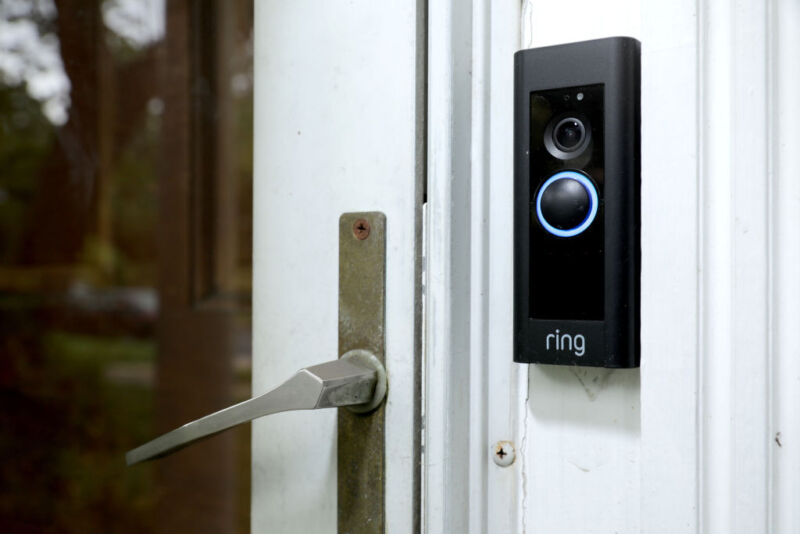Neighborhood watch —
Warrantless access may still be granted during vaguely defined “emergencies.”

Amazon Ring has shut down a controversial feature in its community safety app Neighbors that has allowed police to contact homeowners and request doorbell and surveillance camera footage without a warrant for years.
In a blog, head of the Neighbors app Eric Kuhn confirmed that “public safety agencies like fire and police departments can still use the Neighbors app to share helpful safety tips, updates, and community events,” but the Request for Assistance (RFA) tool will be disabled.
“They will no longer be able to use the RFA tool to request and receive video in the app,” Kuhn wrote.
Kuhn did not explain why Neighbors chose to “sunset” the RFA tool, but privacy advocates and lawmakers have long criticized Ring for helping to expand police surveillance in communities, seemingly threatening privacy and enabling racial profiling, CNBC reported. Among the staunchest critics of Ring’s seemingly tight relationship with law enforcement is the Electronic Frontier Foundation (EFF), which has long advocated for Ring and its users to stop sharing footage with police without a warrant.
In a statement provided to Ars, EFF senior policy analyst Matthew Guariglia noted that Ring had launched the RFA tool after EFF and other organizations had criticized Ring for allowing police to privately email warrantless requests for footage in the Neighbors app. Rather than end requests through the app entirely, Ring appeared to see the RFA tool as a middle ground, providing transparency about how many requests were being made, without ending police access to community members readily sharing footage on the app.
“Now, Ring hopefully will altogether be out of the business of platforming casual and warrantless police requests for footage to its users,” Guariglia said.
Moving forward, police and public safety agencies with warrants will still be able to request footage, which Amazon documents in transparency reports published every six months. These reports show thousands of search warrant requests and even more “preservation requests,” which allow government agencies to request to preserve user information for up to 90 days, “pending the receipt of a legally valid and binding order.”
“If we are legally required to comply, we will provide information responsive to the government demand,” Ring’s website says.
Ring rebrand embraces “hope and joy”
Guariglia said that Ring sunsetting the RFA tool “is a step in the right direction,” but it has “come after years of cozy relationships with police and irresponsible handling of data” that has, for many, damaged trust in Ring.
In 2022, EFF reported that Ring admitted that “there are ’emergency’ instances when police can get warrantless access to Ring personal devices without the owner’s permission.” And last year, Ring reached a $5.8 million settlement with the Federal Trade Commission, refunding customers for what the FTC described as “compromising its customers’ privacy by allowing any employee or contractor to access consumers’ private videos and by failing to implement basic privacy and security protections, enabling hackers to take control of consumers’ accounts, cameras, and videos.”
Because of this history, Guariglia said that EFF is “still deeply skeptical about law enforcement’s and Ring’s ability to determine what is, or is not, an emergency that requires the company to hand over footage without a warrant or user consent.”
EFF recommends additional steps that Ring could take to enhance user privacy, like enabling end-to-end encryption by default and turning off default audio collection, Guariglia said.
Bloomberg noted that this change to the Neighbors app comes after a new CEO, Liz Hamren, came on board, announcing that last year “Ring was rethinking its mission statement.” Because Ring was adding indoor and backyard home monitoring and business services, the company’s initial mission statement—”to reduce crime in neighborhoods”—was no longer, as founding Ring CEO Jamie Siminoff had promoted it, “at the core” of what Ring does.
In Kuhn’s blog, barely any attention is given to ending the RFA tool. A Ring spokesperson declined to tell Ars how many users had volunteered to use the tool, so it remains unclear how popular it was.
Rather than clarifying the RFA tool controversy, Kuhn’s blog primarily focused on describing how much Ring users loved “heartwarming or silly” footage like a “bear relaxing in a pool.” Under Hamren and Kuhn’s guidance, it appears that the Neighbors app is embracing a new mission of connecting communities to find “hope and joy” in their areas by adding new features to Neighbors like Moments and Best of Ring.
By contrast, when Ring introduced the RFA tool, it said that its mission was “to make neighborhoods safer for everyone.” On a help page, Ring bragged that police had used Neighbors to recover stolen guns and medical supplies. Because of these selling points, Ring’s community safety features may still be priorities for some users. So, while Ring may be ready to move on from highlighting its partnership with law enforcement as a “core” part of its service, its users may still be used to seeing their cameras as tools that should be readily accessible to police.
As law enforcement agencies lose access to Neighbors’ RFA tool, Guariglia said that it’s important to raise awareness among Ring owners that police can’t demand access to footage without a warrant.
“This announcement will not stop police from trying to get Ring footage directly from device owners without a warrant,” Guariglia said. “Ring users should also know that when police knock on their door, they have the right to, and should, request that police get a warrant before handing over footage.”